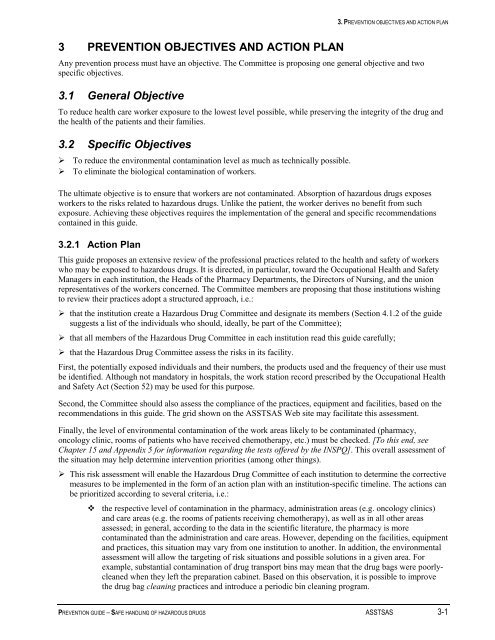Prevention Guide - Safe Handling of Hazardous Drugs - Irsst
Prevention Guide - Safe Handling of Hazardous Drugs - Irsst
Prevention Guide - Safe Handling of Hazardous Drugs - Irsst
Create successful ePaper yourself
Turn your PDF publications into a flip-book with our unique Google optimized e-Paper software.
3. PREVENTION OBJECTIVES AND ACTION PLAN<br />
3 PREVENTION OBJECTIVES AND ACTION PLAN<br />
Any prevention process must have an objective. The Committee is proposing one general objective and two<br />
specific objectives.<br />
3.1 General Objective<br />
To reduce health care worker exposure to the lowest level possible, while preserving the integrity <strong>of</strong> the drug and<br />
the health <strong>of</strong> the patients and their families.<br />
3.2 Specific Objectives<br />
‣ To reduce the environmental contamination level as much as technically possible.<br />
‣ To eliminate the biological contamination <strong>of</strong> workers.<br />
The ultimate objective is to ensure that workers are not contaminated. Absorption <strong>of</strong> hazardous drugs exposes<br />
workers to the risks related to hazardous drugs. Unlike the patient, the worker derives no benefit from such<br />
exposure. Achieving these objectives requires the implementation <strong>of</strong> the general and specific recommendations<br />
contained in this guide.<br />
3.2.1 Action Plan<br />
This guide proposes an extensive review <strong>of</strong> the pr<strong>of</strong>essional practices related to the health and safety <strong>of</strong> workers<br />
who may be exposed to hazardous drugs. It is directed, in particular, toward the Occupational Health and <strong>Safe</strong>ty<br />
Managers in each institution, the Heads <strong>of</strong> the Pharmacy Departments, the Directors <strong>of</strong> Nursing, and the union<br />
representatives <strong>of</strong> the workers concerned. The Committee members are proposing that those institutions wishing<br />
to review their practices adopt a structured approach, i.e.:<br />
‣ that the institution create a <strong>Hazardous</strong> Drug Committee and designate its members (Section 4.1.2 <strong>of</strong> the guide<br />
suggests a list <strong>of</strong> the individuals who should, ideally, be part <strong>of</strong> the Committee);<br />
‣ that all members <strong>of</strong> the <strong>Hazardous</strong> Drug Committee in each institution read this guide carefully;<br />
‣ that the <strong>Hazardous</strong> Drug Committee assess the risks in its facility.<br />
First, the potentially exposed individuals and their numbers, the products used and the frequency <strong>of</strong> their use must<br />
be identified. Although not mandatory in hospitals, the work station record prescribed by the Occupational Health<br />
and <strong>Safe</strong>ty Act (Section 52) may be used for this purpose.<br />
Second, the Committee should also assess the compliance <strong>of</strong> the practices, equipment and facilities, based on the<br />
recommendations in this guide. The grid shown on the ASSTSAS Web site may facilitate this assessment.<br />
Finally, the level <strong>of</strong> environmental contamination <strong>of</strong> the work areas likely to be contaminated (pharmacy,<br />
oncology clinic, rooms <strong>of</strong> patients who have received chemotherapy, etc.) must be checked. [To this end, see<br />
Chapter 15 and Appendix 5 for information regarding the tests <strong>of</strong>fered by the INSPQ]. This overall assessment <strong>of</strong><br />
the situation may help determine intervention priorities (among other things).<br />
‣ This risk assessment will enable the <strong>Hazardous</strong> Drug Committee <strong>of</strong> each institution to determine the corrective<br />
measures to be implemented in the form <strong>of</strong> an action plan with an institution-specific timeline. The actions can<br />
be prioritized according to several criteria, i.e.:<br />
the respective level <strong>of</strong> contamination in the pharmacy, administration areas (e.g. oncology clinics)<br />
and care areas (e.g. the rooms <strong>of</strong> patients receiving chemotherapy), as well as in all other areas<br />
assessed; in general, according to the data in the scientific literature, the pharmacy is more<br />
contaminated than the administration and care areas. However, depending on the facilities, equipment<br />
and practices, this situation may vary from one institution to another. In addition, the environmental<br />
assessment will allow the targeting <strong>of</strong> risk situations and possible solutions in a given area. For<br />
example, substantial contamination <strong>of</strong> drug transport bins may mean that the drug bags were poorlycleaned<br />
when they left the preparation cabinet. Based on this observation, it is possible to improve<br />
the drug bag cleaning practices and introduce a periodic bin cleaning program.<br />
PREVENTION GUIDE – SAFE HANDLING OF HAZARDOUS DRUGS ASSTSAS 3-1

















